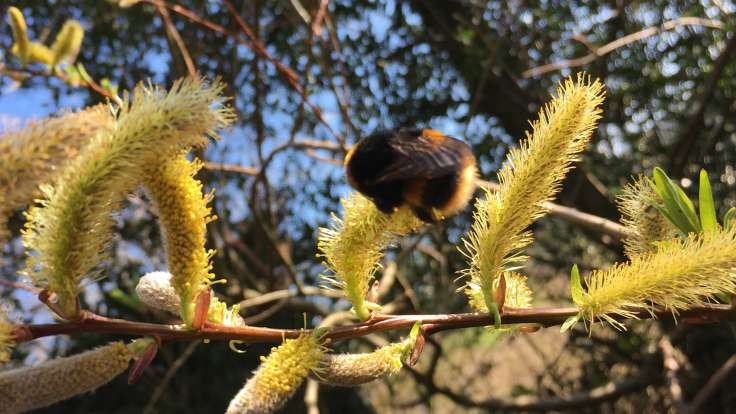
Willow is the most important spring flower for honey bees, based on DNA research. I know, it’s a bumblebee…
Orchards need pollinators, which in turn need particular help in spring. Based on DNA barcoding research by @WalesBotanic, these are the top spring flowers. This article first appeared in The People’s Orchard Newsletter.
Steve Wilson, the tutor at a recent People’s Orchard grafting workshop, discussed how his wildflower meadow encourages pollinators. I mentioned the research headed by Dr Natasha de Vere at Wales Botanic Garden uses DNA barcoding, where a plant is identified by a short section of DNA, to analyse the pollen foraged by pollinators. This way, the flowers most favoured by pollinators can be identified.
Currently, only the results for spring flowers foraged by honey bees have been published but PhD student Laura Jones is close to publishing more results for honey bees, whilst PhD student Abigail Lowe should have some results for wild pollinators by the end of the summer.
Spring flowers are critical in providing nectar and pollen for pollinators which have recently emerged from hibernation, and which are about to start new broods. The flowers are, in order of the most foraged:
- Willow (Salix species)
- Hawthorn (Crataegus monogyna)
- Cotoneaster (eg Cotoneaster horizontalis)
- Apple and cherry trees (Malus and Prunus species)
- Gorse (Ulex europaeus)
- Sycamore and other Acer species
- Hellebores (Helleborus species)
- Dandelions (Taraxacum officinale)
- Holly (Ilex species)
- Oak (Quercus species)
Help pollinators in your orchard in spring by planting a willow and a hawthorn. For the smaller garden, there are more compact willow varieties, and there are also some fantastic fruiting hawthorns: take a look at the Plants For A Future website.
From a forest garden perspective, these spring flowers can be supplemented with Dandelion, Marsh Marigold, Gorse, Purple Deadnettle and Winter Heath—all of these provide both nectar and pollen (Appendix 3, Creating a Forest Garden book).
At the Botanic Gardens, PhD student Lucy Witter is creating an open access list of the best plants for pollinators based on the DNA research, as well creating and testing pollinator friendly seed mixes.
Until this year-round advice is published, there are plenty of other sources for finding bee and pollinator friendly plants. My personal favourites include Comfrey, Borage and Purple Loosestrife, or you can try the Bumblebee Conservation Trust’s Bee Kind Flower Finder!